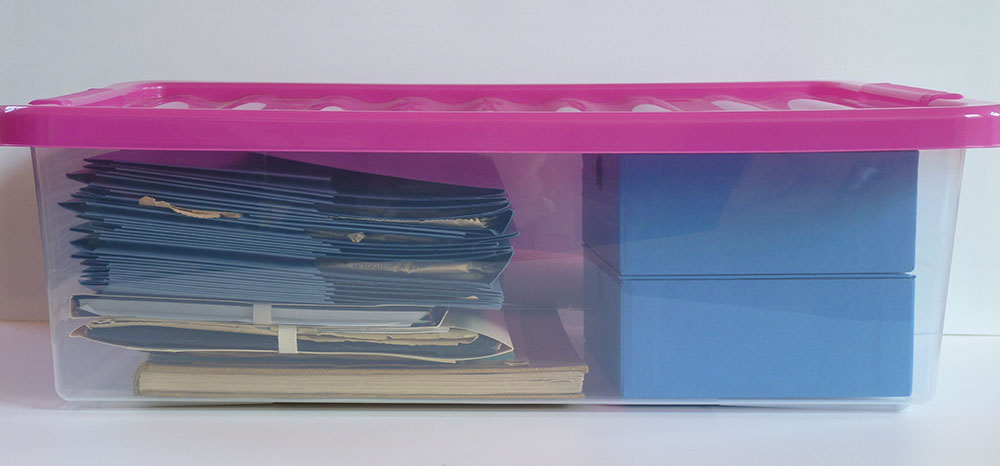Last week we established the importance of treasuring our family archives, and the value of doing so during this period of Lockdown. We also went through some tips on the best way to begin sorting through your archives at home, how to choose what to keep and how to avoid accidentally disposing of valuable archive material!
Hopefully you have had a chance since last week’s ‘At Home With Your Archive’ to go through your family records and see what you have, buried in the attic! Some of you have even sent us some photographs of your most treasured archive objects and records which were wonderful to see!
This time I am going to introduce to you some things to consider when storing your family archive and tips on how to ensure the longevity of your records so that future generations can learn from them.
First of all, we all need to know what we have got. However, it’s vital to remember that some archive material is difficult to understand or interpret without the associated stories and histories passed down through families through ‘oral tradition’. Therefore, if you know, for example, who is in a photograph, it is useful to store it in such a way that it can be labelled appropriately with its subjects, stories and contexts. Furthermore, there are some easy ways in which you can protect against the things that threaten the long-term preservation of your treasured family archives such as dust and damp as well as handling and other archive material.

Some really useful equipment: brass paperclips, cotton tape and acid-free card.
Here is some practical advice on storing and labelling your family records:
- In many cases, things that threaten your most fragile and vulnerable family records are other objects in your archive. Anything sticky, staining or abrasive needs to be kept away from other records and remember not to introduce any new threats such as sticky-tape or wet ink.
- Try to avoid writing on your records to label them as this can damage them. Instead, store them in a way that enables you to label their packaging or mounting, like in an album with space for captions or individually packaged and labelled on the packaging. Another useful method is overlaying acid-free tissue paper to identify faces in photographs but be sure not to trace on top of the original as you will damage the surface and remember to use a soft pencil!
- Acid-free card folders are useful for all kinds of flat, paper records. Use 1 folder for 1 or 2 small, thicker objects like very old photographs printed on thick card or for several sheets of paper like a series of letters. If you want to group sheets, remember to use brass paper clips as they don’t rust! Unbleached cotton tape is also useful for securing folders and bundles.
- Store everything you can flat, as this can reduce damage to the edges of delicate records.
- When boxing things up, put heavier items at the bottom, and lighter more delicate things on top. Make sure to fill up small boxes as you don’t want to be lifting dangerously big, awkward & heavy boxes not only for your back but for the safety of your precious family archive!

A flat archive is a happy archive!
A quick word about Film
All kinds of photographic negatives and prints are easily damaged and exist in a volatile state so be sure to store them as safely as you can. If you have home-video tapes or films, these can be very fragile and can deteriorate quickly without you noticing.
So that you do not lose valuable records, tapes and films can be ‘digitised’ by professionals using various methods. For now store them flat somewhere cool and dry, then once archives and museums are back to normal, consult your local heritage organisation for further guidance.
There may be a film heritage organisation near you that collects and preserves valuable film footage, especially if it is a record of local people, places and events and they may be able to digitise your film post-Lockdown, so do some searching around in your area!

Acid-free tissue is very useful for packing around old, delicate objects, especially textiles like toys and clothing.
Finally, here are some activities that will contribute towards the preservation of your treasured family archives as well as keep you entertained during Lockdown:
- Go through your family archive and identify any fragile, damaged or very old records and make sure they are stored flat and away from anything that could damage them. Remember that if something has been stored folded, it’s best to leave it folded as trying to flatten folds can cause tears!
- Take a look at the Museum of London’s handling guide so that you can be confident in the preservation of your family records when they are being handled by those that can enjoy them and learn from them. This guide was designed for museum collections but most, if not all you learn from it can be applied to your family archive!
- Check out the UK National Archives boredom-busting activities on their website. Their guide to how to date family photographs is perfect for helping you identify and label your treasured records!
- Pick a photograph, letter, postcard or other record that brings you joy or inspires you and show it to a friend or member of your family. If they aren’t in your household during Lockdown, use social media such as Skype or FaceTime to get in touch and share your treasured archives!
